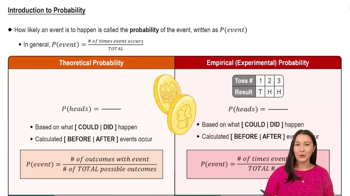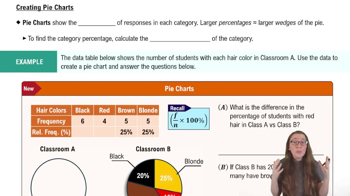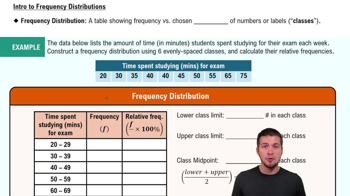29. Explain, in your own words, why in the Addition Rule for P(A or B or C), P(A and B and C) is added at the end of the formula.
Table of contents
- 1. Intro to Stats and Collecting Data1h 14m
- 2. Describing Data with Tables and Graphs1h 55m
- 3. Describing Data Numerically2h 5m
- 4. Probability2h 16m
- 5. Binomial Distribution & Discrete Random Variables3h 6m
- 6. Normal Distribution and Continuous Random Variables2h 11m
- 7. Sampling Distributions & Confidence Intervals: Mean3h 23m
- Sampling Distribution of the Sample Mean and Central Limit Theorem19m
- Distribution of Sample Mean - Excel23m
- Introduction to Confidence Intervals15m
- Confidence Intervals for Population Mean1h 18m
- Determining the Minimum Sample Size Required12m
- Finding Probabilities and T Critical Values - Excel28m
- Confidence Intervals for Population Means - Excel25m
- 8. Sampling Distributions & Confidence Intervals: Proportion1h 12m
- 9. Hypothesis Testing for One Sample3h 29m
- 10. Hypothesis Testing for Two Samples4h 50m
- Two Proportions1h 13m
- Two Proportions Hypothesis Test - Excel28m
- Two Means - Unknown, Unequal Variance1h 3m
- Two Means - Unknown Variances Hypothesis Test - Excel12m
- Two Means - Unknown, Equal Variance15m
- Two Means - Unknown, Equal Variances Hypothesis Test - Excel9m
- Two Means - Known Variance12m
- Two Means - Sigma Known Hypothesis Test - Excel21m
- Two Means - Matched Pairs (Dependent Samples)42m
- Matched Pairs Hypothesis Test - Excel12m
- 11. Correlation1h 6m
- 12. Regression1h 50m
- 13. Chi-Square Tests & Goodness of Fit1h 57m
- 14. ANOVA1h 57m
4. Probability
Addition Rule
Problem 3.RE.34
Textbook Question
In Exercises 33 and 34, use the pie chart at the left, which shows the percent distribution of the number of students in U.S. public schools in a recent year. (Source: U.S. National Center for Education Statistics)

34. Find the probability of randomly selecting a school with 300 or more students.
 Verified step by step guidance
Verified step by step guidance1
Identify the relevant categories in the pie chart that represent schools with 300 or more students. These categories are '300–499', '500–999', and '1000 or more'.
Determine the percentage of students in each of these categories from the pie chart: '300–499' is 28.1%, '500–999' is 32.7%, and '1000 or more' is 9.4%.
Add these percentages together to find the total percentage of students in schools with 300 or more students. Use the formula: Total Percentage = Percentage(300–499) + Percentage(500–999) + Percentage(1000 or more).
Convert the total percentage into a probability. Since percentages are out of 100, divide the total percentage by 100 to express it as a probability.
Interpret the result as the probability of randomly selecting a school with 300 or more students.
 Verified video answer for a similar problem:
Verified video answer for a similar problem:This video solution was recommended by our tutors as helpful for the problem above
Video duration:
1mPlay a video:
Was this helpful?
Key Concepts
Here are the essential concepts you must grasp in order to answer the question correctly.
Probability
Probability is a measure of the likelihood that a particular event will occur, expressed as a number between 0 and 1. In this context, it refers to the chance of randomly selecting a school with 300 or more students from the total distribution shown in the pie chart.
Recommended video:

Introduction to Probability
Pie Chart Interpretation
A pie chart visually represents data as slices of a circle, where each slice corresponds to a category's proportion of the whole. Understanding how to read the percentages in the pie chart is essential for determining the probability of selecting a school based on its student population.
Recommended video:

Creating Pie Charts
Cumulative Distribution
Cumulative distribution refers to the total percentage of observations that fall below a certain value. To find the probability of selecting a school with 300 or more students, one must calculate the cumulative percentage of schools with fewer than 300 students and subtract it from 100%.
Recommended video:
Guided course

Intro to Frequency Distributions

 5:14m
5:14mWatch next
Master Probability of Mutually Exclusive Events with a bite sized video explanation from Patrick
Start learningRelated Videos
Related Practice
Textbook Question
